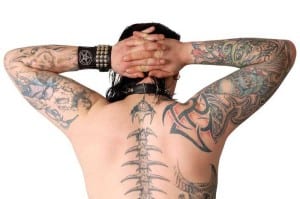BALTIMORE, MD – Johns Hopkins researchers published a shocking new study in this month’s New England Journal of Medicine showing a correlation between the quantity, location, and type of tattoos on a patient’s body and the level of anxiety experienced when given IV needle sticks.

Patients without tattoos coped best with needle sticks, with 45% of them taking a deep breath and looking away, 32% of them watching and talking, and 17% of them cracking jokes during the process. Only 6% cried during the process, averaging 1.3ml of lacrimal fluid secretion.
Patients with 1 or 2 tattoos demonstrated only a slight increase in anxiety, with most begging the phlebotomist to “wait a minute” before being stuck. Many participants in this category had butterflies, flowers, or Disney characters tattooed in various locations.
Patients with multiple tattoos meant to indicate toughness or rebellion had the highest anxiety, especially 18-25 year old males with criminal records. The most common tattoos in this category included barbed wire around the upper arm, “Thug Life” or “Love Hate” on the knuckles, flaming skulls, and Chinese characters on Caucasian patients. Results in this category were as follows:
- 40% insisted their tattoos did not hurt, but 97% reported “hating needles” before the stick
- 55% asked for numbing medication to first be applied to the site
- 22% became nauseated and light-headed when the tourniquet was applied
- 33% cried, secreting 3.6ml of lacrimal fluid
- 21% left AMA
- 9% proceeded to suck their thumb afterwards.
Christine was astounded, stating “Females with tramp stamps and males with neck tattoos were the most anxious study participants. Apparently having a nurse who has done thousands of IV sticks was scarier for them than a leather-clad stranger with a GED plunging in a needle into the skin directly above the carotid artery.”
Researchers were given a $500,000 taxpayer grant for the research, with four recommendations in order to create a more tattoo parlor-like ambiance to alleviate needle anxiety: Hang a half-lit neon sign in the window, fill the room with the smell of smoke, rename ‘phlebotomist’ to ‘artist’, and put a small amount of ink in each needle.